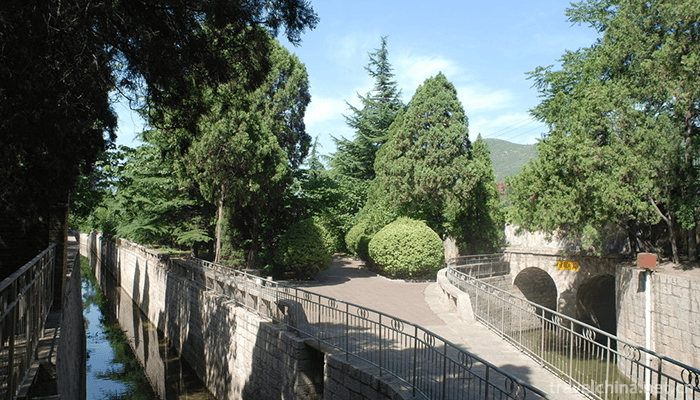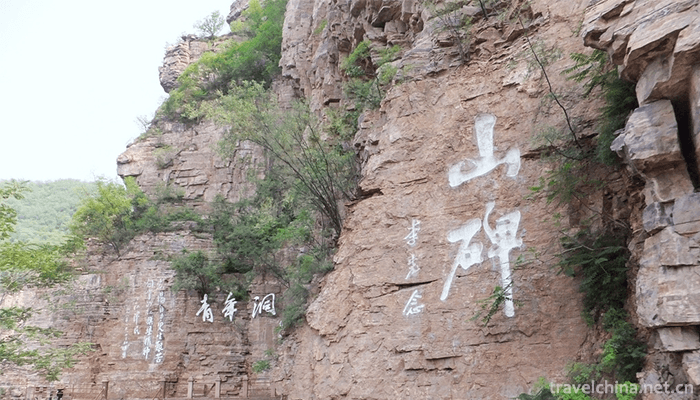Red Flag Canal Scenic Area
Red Flag Canal Scenic Area is a national AAAAA class scenic area, covering an area of five square kilometers. Red Flag Canal Scenic Area is composed of Red Flag Canal Water Distribution Garden and Youth Cave Scenic Area, mainly including Red Flag Canal Memorial Hall, Water Dividing Gate and Luositan Waterfall.
Red Flag Canal Scenic Area is known as "China's Great Wall of Water" in the international community as "the eighth wonder of the world". In September 1996, it was jointly named "National Patriotic Education Base for Primary and Secondary Schools" by six ministries and commissions. In 2009, it was awarded the title of "National Geopark" by the Bureau of Land and Resources. In October 2016, it was approved as a national 5A tourist attraction.
Historical evolution
From October to November 1959, Linxian hydraulic engineers and technicians surveyed the route selection for the irrigation project of introducing Zhang into the forest.
On February 11, 1960, the irrigation project of introducing Zhang into forests in Linxian County began to work until the 15th.
On May 1, 1960, the Wangjiazhuang Safety Cave and Linying Aqueduct were completed at the same time.
On October 1, 1960, the first phase of the main canal of Linxian Hongqi Canal (from the head of the canal to the estuary) was completed, and the water from the turbid Zhanghe River flowed into Linxian.
On October 17, 1960, the second phase of the main canal of the Hongqi Canal (from the estuary to Mujiazhuang section) was started. Completed on September 30, 1961.
On July 15, 1961, the Youth Cave of the Red Flag Canal Main Canal was completed.
On October 1, 1961, the third phase of the main canal of Hongqi Canal (Nangudong to Fentouling Section) was started. Completed on October 1, 1962.
On October 20, 1962, the fourth phase of the main canal of Hongqi Canal (Mujiazhuang to Nangudong Section) was started.
On 20 January 1963, the diversion tunnel at the tail of the main canal of Hongqi Canal was completed.
On October 30, 1964, the fourth phase of the main canal project (Mujiazhuang-Nangudong) was completed.
On December 1, 1964, the main canal of the Red Flag Canal was opened. On 31 March, the first water release from the main canal was successful.
On April 5, 1965, the county Party committee and the county people's Committee held a ceremony celebrating the opening of the main canal of the Red Flag Canal at the watershed.
On July 21, 1965, the Third Congress of Linxian County of the Communist Party of China designated April 5 as the anniversary of the opening of the Red Flag Canal.
On April 1, 1966, the Taoyuan aqueduct of a main canal was completed.
On April 5, 1966, the Duofeng aqueduct of the Second Main Canal and Shuguang Tunnel of the Third Main Canal were completed. The first, second and third main canals have been fully completed.
From July to August 1966, on the basis of the completion of the first, second and third main canals of the Red Flag Canal, the people of Linxian County launched a complete set of branch canals.
In October 1970, the maintenance and reinforcement project from Linying Cave to Tongtiangou, the main canal of Hongqi Canal, was started. Completed in April 1971. The Ministry of Water and Electricity held an exhibition of the Red Flag Canal, and the Red Flag Canal began to open to the outside world.
In January 1971, Hongying Confluence Power Station was started and completed in December 1973.
In October 1972, the maintenance and reinforcement of Yangerzhuang to watershed of the main canal of Hongqi Canal began. It was completed in June the following year.
In October 1973, the maintenance and reinforcement works of the main canal of the Hongqi Canal from the estuary to Yangerzhuang, including the reconstruction of the Sigou Cave of the main canal, were completed in August 1974.
In October 1975, the Red Flag Canal Memorial Pavilion was built in the watershed.
In April 1977, the "Red Flag Aqueduct" in Fangjiazhuang, Chengguan Commune, was built. It is the first reinforced concrete thin-shell aqueduct in Linxian County, with a total length of 1275 meters and a total of 104 holes at the highest point of 19.6 meters.
On March 20, 1982, after the 250-metre execution at the east of Wangjiazhuang Village in Shanxi Province, the reconstruction of the main canal of Hongqi Canal began. Completion on July 1.
On October 25, 1991, the construction of turning over and laying the bottom of Hongying North Branch Trunk Canal began. The project is 13.8 kilometers long from Xiaodian Township Oil Village to Nanyu Baiganling Township of Mulberry Mining. Construction is undertaken by Hejian and Mulberry Mining Township.
On April 15, 1992, the first phase of the technical renovation project of turning over and laying the bottom of Hongying South Branch Channel was started.
In September 1992, the Red Flag Canal Tourist Area Luositan Scenic Area was built.
On October 24, 1992, 14.3 kilometres of Taoyuan branch canal (Taoyuan Yiqu Mountain Xiangling Cave) of Hongqi Canal was constructed, and the technical renovation and laying of the bottom was started. Completion on 30 November.
On April 1, 1993, the county Party committee and the county government convened a meeting of all members of the general headquarters of technical renovation and construction of the main canal of the Red Flag Canal. The mobilization meeting was held on the morning of the 2nd. On April 15, the main canal was closed and the whole line was constructed.
On June 30, 2009, the water-saving renovation project of Hongqi Canal Irrigation Area in 2008 mainly included the renovation and renovation of 20 kilometers and 11 kilometers of Hongying Canal in Shanxi Province, with a total investment of 30 million yuan.
On November 10, 2009, the renewal and water-saving renovation project of Hongyingnan branch canal of Hongqi Canal was started.
On June 21, 2014, the launching ceremony of Anyang Intelligent Tourism and the "One Yuan Tour to Red Flag Canal" was held in the Red Flag Canal Water Distribution Garden Scenic Area.
geographical environment
geographical position
Hongqi Canal Scenic Area is located at the junction of Henan, Shanxi and Hebei provinces in the northern part of Linzhou City, Henan Province. It is in the center of Anyang, Xinxiang, Hebi, Changzhi and Handan. Under Niuling Mountain Village, 20 kilometers from the urban area. The longitude of East is 113.824362 and the latitude of north is 36.237878.
Climatic characteristics
Red Flag Canal Scenic Spot is a warm temperate semi-continental monsoon climate with distinct seasons and abundant sunshine. Spring is warm and windy, summer is hot and rainy, autumn is wet and cool, winter is cold and snowy. The average annual temperature is 14.5 C. The extreme maximum air temperature is 42.3 C and the minimum air temperature is - 15.5 C. July is the hottest month in a year, with an average temperature of 31.9 C and the coldest month in January, with an average temperature of -2 C. The annual average precipitation is 664.9 mm, which varies greatly from year to year. The annual distribution is uneven, mainly concentrated in the four months of June, July, August and September.
Resource situation
water resource
Hongqi Canal Scenic Area has formed a water conservancy network combining diversion, storage and lifting. More than 400 reservoirs and ponds have been built, more than 80 medium and small hydropower stations have been built, and the irrigation area is 400,000 mu.
mineral resources
Mineral resources are abundant. The proven mineral resources include iron, cobalt, magnesium, lead, niobium, tantalum, limestone, dolomite, granite, marble, slate, silica, cast stone, calcite, Iceland stone, wollastonite, crystal, potassium feldspar, phosphorus-bearing rock, coal, refractory clay, building stone, brick clay, River sand, maifanshi, etc.
plant resources
There are Dangshen, Bupleurum, Yuanshen, Angelica sinensis, Scutellaria baicalensis, Yuanhu, Polygala tenuifolia, Banlangen, Ganoderma lucidum and other medicinal materials growing in the forest grassland.
Main attractions
Youth cave
Youth Cave is located below Xiniuling Mountain of Ren Village, Lujia Village, Ren Village, the main canal of Hongqi Canal. It is the longest tunnel of the main canal. The Youth Cave passes through the mountainside of the Taihang Mountains, where the terrain is dangerous and the stone is hard. The original cave is 616 meters long, the length behind the face is 623 meters, the height is 5 meters, the width is 6.2 meters, the longitudinal slope is 1/1500, the design flow volume is 23 cubic meters/second, the excavation and masonry square is 19800 cubic meters, 130,000 works are put into operation, and the cost is 230,000 yuan.
On July 15, 1961, a tunnel was excavated and named Youth Cave. In 1973, Guo Moruo, vice chairman of the Standing Committee of the National People's Congress, wrote the name of the cave in his own hand.
Ten water tablet
This stele is called the "Shishuiyan" stele. The inscription was written by Yang Gui, former consultant of the Poverty Alleviation Office of the State Council and Secretary of Yuanlin County Party Committee. The full text is "ancestors lack water for generations, the Red Flag Canal brings Zhanghe River water, the reservoir stores Valley water, the Red Flag Canal fills the reservoir pool water, irrigates the ground canal reservoir pool to release water, one canal water can top two canals water, levels the land to water rationally, everybody comes to save water, the key is to keep the canal well managed water, Linxian will no longer worry about water shortage".
Tiger mouth cliff
Hukouya cliff, the cliff is hundreds of feet high, the cliff protrudes more than ten meters outward, like the big opening of the tiger. When repairing the canal, loose stones sometimes fell down and hit people. Ren Yangcheng, the commander of the danger removal team, took his team members with him. He swung on the swing like an eagle in the air several times before he could enter the mouth of the tiger and remove dangerous stones. People called it "Hukou tusk pulling". So the cliff was called "Hukou cliff".
Sluice gate
The main canal of the Red Flag Canal is divided into three main canals. It travels far from the mountains and goes deep into the hinterland of Linzhou, moistening 540,000 good fields in Linzhou. The building is 6.5 metres long, 12 metres high and 13.5 metres wide. The gate bottom elevation is 454.44 metres, and the elevation is 10.31 metres lower than the bottom of the intake gate at the head of the canal. Guo Moruo's "Red Flag Canal" is one of the landmark buildings of the Red Flag Canal.
Luositan Waterfall
Luositan is the most spectacular break in the eighteen faults of Zhanghe Jiuxia, a famous scenic spot: the broken overpass. The breaker falls. Water forms a semi-circular waterfall at the bottom of the upper valley, which is like a pot mouth.
Corridor bridge
The Landscape Bridge, the landmark building of the main entrance of the Youth Cave, is the extension of the form of the Red Flag Canal and the sublimation of the spirit of the Red Flag Canal. Set ticketing services, shopping, transportation and other functions as a whole, in solving the basic functions of cross-provincial road safety for tourists at the same time, built a scenic landscape project.
Red Flag Canal Memorial
The Red Flag Canal Memorial Hall is an exhibition hall for collecting, researching, displaying and inheriting the history of the Red Flag Canal. The name of the library was inscribed by Zhao Puchu, former vice-chairman of the CPPCC National Committee. The building area of the memorial hall is more than 6300 square meters and the exhibition area is 2950 square meters.
Pioneering hole
In the most difficult period, the workers of Dongyao Commune began to dig the entrepreneurship cave. The cave is 63 meters long, 5 meters high and 6.3 meters wide.
Two and a half mountains
The mountainside of the Taihang Mountains was split and knocked on the cliff wall. Finally, two halves of the mountain were obtained.
Unity hole
Linqi Commune, located in the southernmost part of Linxian County, belongs to the non-beneficiary area of Hongqi Canal. The tunnel is 26 meters long, 5 meters high and 6.3 meters wide.
Old hole
Old guns are also called artillery, because the rocks here belong to quartz sandstone, stone is very hard, hammer hit down only a small white spot, the canal workers decided to set off old guns here, so there is in the process of canal construction'a gun broke half a mountain'.
Olecranon cliff
Yingzui Cliff is a section of cliff through the Red Flag Canal. The book has three characters of "Yingzui Mountain". Looking up, the cliff protruding from the top resembles an eagle standing on the South Bank of the Red Flag Canal.
Thin strip of sky
It's more than 50 meters long and 0.4 meters wide. It's only for one person to walk alone. It's still necessary for people with strong body and wide body to suck their stomachs sideways before they can pass through. Looking up at the end of the cliff, there is only a ray of sky; looking back, the outside becomes a line world.
God shop
The eaves of the cliffs where the migrant workers built canals lived were called "divine workshops".
Suspended cableway
A ropeway links the two mountains and is regarded as a representative scenic spot of the present Hongqi Canal Scenic Area.
Tourist guide
Traffic routes
transit
From Zhengzhou: Bus (Zhengzhou-Xinxiang-Linzhou-Hongqi Canal)
(2) Starting from Anyang: Bus (Anyang-Linzhou-Hongqi Canal)
(3) Starting from Shijiazhuang: Bus (Shijiazhuang-Xingtai-Handan-Anyang-Linzhou-Hongqi Canal)
Self driving route
(1) Take the highway: Zhengzhou Liulin Station, Shangshang Expressway - Anyang - Anlin Expressway - Linchang Expressway, Hongqi Canal Scenic Spot Exit, South Turn Southeast Highway to Hongqi Canal Scenic Spot Memorial Hall.
(2) Low speed: Zhengzhou - Yellow River Bridge - Xinxiang Huixian (Huixian turntable left turn) - Linzhou, to Linzhou after the Southeast highway, can go directly to Hongqi Canal Scenic Area.
Tourist route
Fenshuiyuan Scenic Area
Arrived at 9:00 a.m. and visited the Water Conservancy Science Park - Red Flag Canal Memorial Hall - Red Flag Canal Monument - Water Gate - Red Flag Canal Main Canal - First Main Canal - Second Main Canal, etc. to fully understand the history of the construction of the Red Flag Canal and to realize the spirit of the Red Flag Canal.
Youth Cave Scenic Area
Boarding the red ribbon Gallery bridge, overlooking the spectacle of Zhanghe River and the scenery of three provinces, climbing up the red flag canal bank, hiking to visit Zhangjialing - Laoziya - Fork Trench - Sanguanting - the landscape platform of the two halves of the mountain, and arriving here:
A line
Feel the pleasure of boating on the Tianhe River, cross the Youth Cave and experience the hardships of the years in the cave.
B line
Continuing to walk along the Bank of the Red Flag Canal, visiting such scenic spots as Unity Cave, Yingzui Cliff and Red Flag Canal Monument, we can reach Queqiao Bridge, where there are three roads:
B1 Leadership Road: Continue along the canal bank to reach Youth Cave. Leadership Road is the road that heads of state and leaders at home and abroad take when they inspect the Red Flag Canal. The road is smooth and suitable for the elderly and children.
B2 entrepreneurship road: through Queqiao, along the right bank trestle road, through Hukou Cliff, Shengong Pavilion, to Tianhe Pavilion, and then along the Bank of the Red Flag Canal to Youth Cave. Taking this road can experience the hardship of the migrant workers who build canals.
B3 Scenic Road: From this, climb a line of sky, cross Phoenix Platform, take double lock, reach the top of the mountain, then step over the Yunqiao, climb the Fengyuan of Yangyang, take the slide, and go directly to the Youth Cave.
Return journey
Take the scenic spot sightseeing bottle car back to the parking lot.





0 Questions
Ask a Question
Your email address will not be published.